Hollyhock: A Classic Addition to Your Garden
Hollyhock, known for its tall spikes of colorful flowers, is a charming garden plant that adds vertical interest and classic beauty to any landscape. Here’s a comprehensive guide on growing and caring for Hollyhock.

Types of Hollyhock
Hollyhock comes in various types, each with unique characteristics. Here are some common types:
| Type of Hollyhock | Characteristics |
|---|---|
| Single Hollyhock | Simple, single-layered petals, available in various colors, blooms in mid to late summer. |
| Double Hollyhock | Full, double-layered petals, creates a lush, pom-pom effect, blooms in mid to late summer. |
| Perennial Hollyhock | Comes back year after year, typically less prone to rust, blooms in mid to late summer. |
Growing Season
Hollyhock typically blooms from mid to late summer, adding vibrant colors to your garden during this period.
| Season | Activity |
|---|---|
| Spring | Plant new Hollyhock, fertilize, start watering regularly. |
| Summer | Continue watering, deadhead spent blooms to encourage more flowers. |
| Fall | Light pruning, collect seeds for next year. |
| Winter | Minimal maintenance, protect from severe frost if necessary. |
Sunlight and Water Needs
Hollyhock thrives in full sun, requiring at least 6-8 hours of direct sunlight daily. They prefer well-drained soil and need regular watering, especially during dry periods. Water deeply once a week, adjusting for weather conditions.
Soil Preferences
Hollyhock prefers well-drained, moderately fertile soil.
| Soil Type | pH Level | Characteristics |
|---|---|---|
| Loamy Soil | 6.0-7.5 | Rich in nutrients, retains moisture well. |
| Sandy Soil | 6.0-7.5 | Drains quickly, may require additional organic matter. |
| Clay Soil | 6.0-7.5 | May need improvement for better drainage, add compost or sand. |
Fertilization and Nutrients
Hollyhock benefits from regular feeding. Use a balanced fertilizer in the spring to promote healthy growth and blooms.
| Season | Fertilization Type |
|---|---|
| Spring | Balanced fertilizer (10-10-10). |
| Summer | Balanced fertilizer if growth is slow. |
| Fall | No fertilization needed, prepare for winter. |
Pruning and Maintenance
Regular maintenance helps keep Hollyhock healthy and blooming. Prune after flowering to maintain shape and remove spent blooms.
Additional Tips for Growing Hollyhock
- Staking: Hollyhocks can grow tall and may require staking to prevent them from falling over.
- Pest Control: Watch out for common pests like aphids and rust. Use organic treatments as necessary.
- Seed Collection: Collect seeds in the fall to plant next spring or share with fellow gardeners.
Conclusion
Hollyhock is a classic addition to any garden, offering tall, colorful blooms with minimal care. From selecting the right type of Hollyhock to ensuring proper sunlight, water, and soil conditions, you can enjoy these beautiful flowers for years to come.